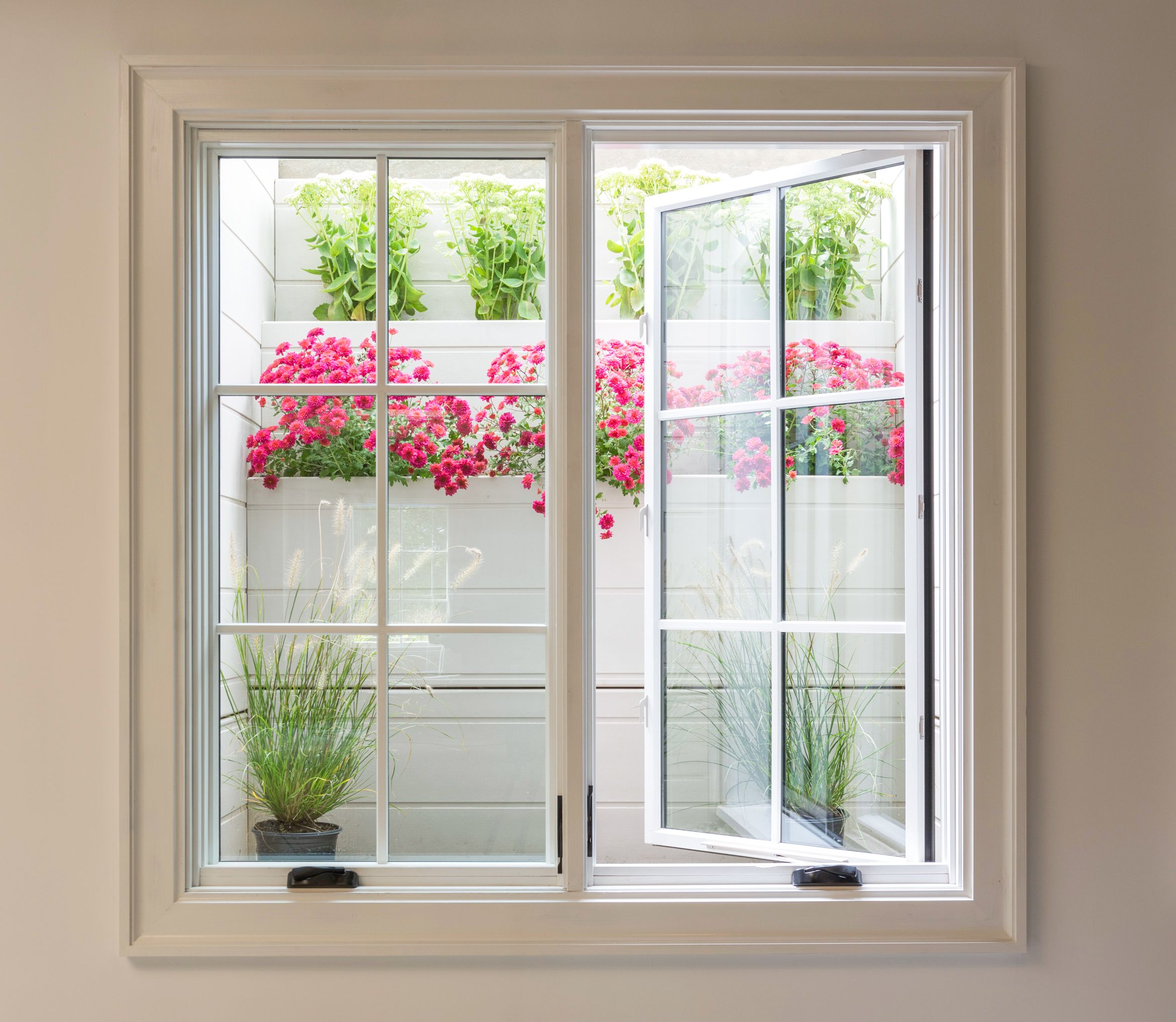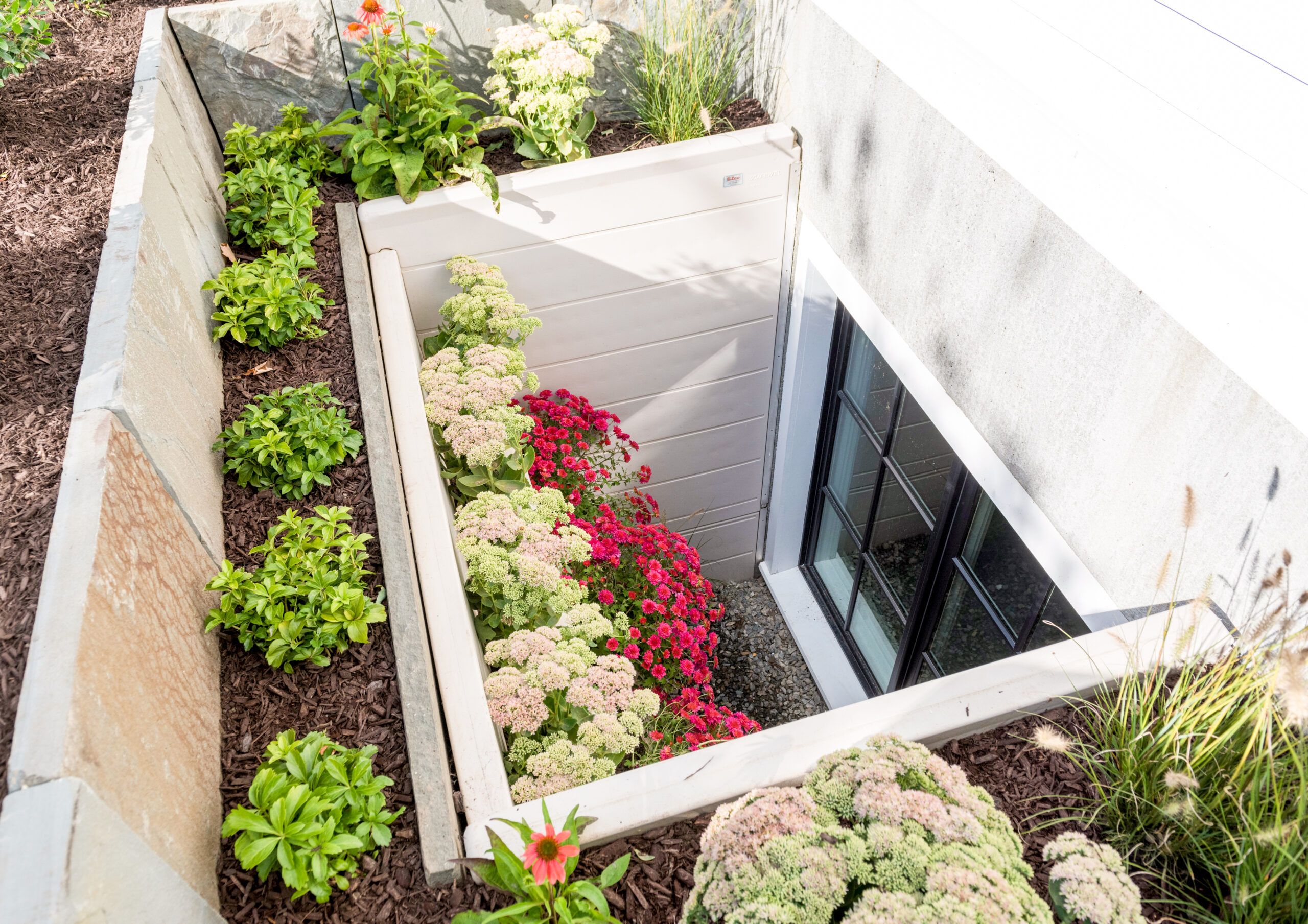Egress windows provide a basement escape route during an emergency while also bringing natural light into lower-level spaces. In many cases, they also add to your property value. Installing an egress window can be a do-it-yourself (DIY) project if you’re handy, but there’s a lot to know about successfully planning and executing a window addition.
Our guide covers egress window installation, including building codes, budgeting, and ongoing maintenance. For general window installation, follow our guide.
What Is an Egress Window?
An egress window is a specially designed window that serves as an emergency exit in case of fire, flooding, or other hazards. Building codes require these windows in bedrooms and habitable basement spaces.

Egress Window Building Codes and Safety Requirements
Before installing an egress window, we recommend researching local building codes and safety requirements. These regulations are in place to ensure your installed window can safely serve its purpose.
Minimum Size Specifications
Egress windows must meet specific size requirements to allow for easy escape and entry by firefighters. Typically, the window must provide an open area of at least 5.7 square feet, with a minimum width of 20 inches and a minimum height of 24 inches. These dimensions ensure that a person can comfortably pass through the opening in an emergency situation.
Accessibility Guidelines
The bottom of an egress window opening can be no higher than 44 inches off the floor, ensuring that occupants can easily reach and operate the window. For basement installations, a window well must be installed outside the foundation, measuring at least 36 inches wide and providing at least 9 square feet of space when the window is open.
Choosing the Right Egress Window
You have options when choosing an egress window. Prioritize the type and material that best suit your budget, climate, and safety needs.
Window Types for Egress
Several window styles, such as casement, sliding, and double-hung windows, meet egress requirements. Many homeowners prefer casement windows because they provide a large, unobstructed opening when fully extended. Sliding and double-hung windows may require larger overall dimensions to meet the minimum open area requirements.
Materials and Durability Considerations
Egress windows are available in vinyl, wood, and fiberglass. Vinyl windows are popular for their low maintenance and energy efficiency, while wood offers a classic look but requires more upkeep. Fiberglass windows provide excellent durability and insulation properties. Choose a material that balances your desired look with practical considerations such as climate and maintenance.
We recommend vinyl if you’re on a tight budget, since it’s among the cheapest window options. Wood provides nice curb appeal, but it can warp and crack if exposed to the hot sun regularly. Fiberglass is our top pick if it’s in your budget. It’s low-maintenance, long-lasting, and weather-resistant for all climates. See our guide on fiberglass versus vinyl windows for more information.
Planning Your Egress Window Installation
Once you choose which window type you want, you have some decisions to make before you can begin the project.
Determining the Ideal Location
You can’t install an egress window just anywhere. Consider factors such as interior room layout, exterior landscaping, and underground utilities. The window should be easily accessible from inside and provide a clear path to the outdoors. Avoid areas with large trees, utility lines, or other obstructions that could impede escape. You should also avoid putting a window in a spot known to collect water after hard rains.
Obtaining Necessary Permits
Before beginning any work or making any purchases, check with your local building department about required permits. Most localities require permits for egress window installations, especially when cutting into a foundation wall. Without the proper permits, expect to be fined and have complications when selling your home. You may find that the window type you’ve selected isn’t going to meet requirements for the space you have and need to choose another.
Preparing to Install Your Egress Window
Unless you’re a home improvement enthusiast, you’ll probably need to look into buying, renting, or borrowing several tools.
Tools and Materials
For an egress window installation, you’ll need the following equipment:
- Caulking gun
- Concrete saw or masonry drill
- Level
- Reciprocating saw
- Safety gear
- Tape measure
Then you’ll need to get these materials in addition to the window unit:
- Concrete anchors
- Gravel for drainage
- Pressure-treated lumber for framing
- Waterproof sealant
Safety should be your top priority when installing an egress window. Wear appropriate protective equipment, such as safety goggles, gloves, and a dust mask. If working with power tools, follow all manufacturer guidelines. When excavating, be aware of underground utilities and take precautions to prevent cave-ins.
Step-by-Step Window Installation Process
If you’re confident in your construction skills, follow the steps below to install the window. Alternatively, Watch our video on how to install a window to see the process and get expert tips.
- Excavate the Window Well
If installing in a basement, begin by excavating the area outside the foundation where the window will be placed. The well should be at least 36 inches wide and extend at least 6 inches beyond the window on each side. Add a layer of gravel at the bottom of the well to encourage proper drainage.
- Cut the Foundation Opening
Cutting through a masonry wall requires special equipment and expertise, so you should have some training before attempting this step. Mark the opening carefully, ensuring it’s the correct size to accommodate the window and framing. Use a concrete saw to cut the opening, working slowly and steadily to maintain control. We advise leaving this step to professionals due to its complexity and the potential for structural issues if not done correctly.
- Frame the Window
Once the opening is cut, install a pressure-treated wood frame to create the rough opening for the window. The frame should be level, plumb, and square. Secure the frame to the foundation using concrete anchors and construction adhesive. Proper framing is crucial for the window’s functionality and longevity.
- Install the Window Unit
With the frame in place, you can now install the window unit. Follow the manufacturer’s instructions carefully, ensuring the window is level and plumb. Secure the window to the frame using the provided fasteners, and apply waterproof sealant around the edges to prevent water infiltration.
- Apply Finishing Touches
Complete the installation by adding interior and exterior trim, caulking all seams, and installing the window well if required. Prioritize proper drainage around the window well to prevent leakage. Consider adding a cover to the window well to keep out debris and increase safety.
DIY vs. Professional Window Installation
Deciding whether to tackle an egress window installation as a DIY project or hire a professional depends on several factors.
When To Consider DIY
DIY installation might be feasible for experienced homeowners working with wood-frame walls on ground level. However, even in these cases, you need to have a thorough understanding of building codes and proper installation techniques. Don’t attempt this project if you’re not familiar with home construction projects. Doing so could mean harm to you and your home.
Benefits of Hiring a Professional
Hiring a professional is the safest and most efficient option for most homeowners, especially those dealing with basement installations or masonry walls. Professionals have the necessary equipment, expertise, and knowledge of local codes to ensure a safe, attractive installation. They can also expertly handle unexpected issues that may arise during the process.
Maintenance and Care for Egress Windows
All windows require some level of maintenance, but those close to the ground need a little more attention to keep them clean and the space outside clear.
Regular Cleaning and Inspection
Clean your egress window and well regularly to remove debris and check for signs of wear or damage. Inspect the window frame, sealant, and drainage system at least twice per year, ideally in spring and fall.
Addressing Common Issues
Watch for common problems such as water leakage, sticking windows, or deteriorating frames. Address these issues promptly to prevent more significant problems. If you notice any structural concerns or major damage, consult a professional for repair or replacement.
Large egress windows can also cause a lack of privacy. You can add some privacy to your window by following our guide to installing window shades.
Window Cost Considerations
According to Angi, installing an egress window costs an average of $4,167 but can range from $2,632—$5,706. This price varies due to several factors, including the following:
- Complexity of installation (basement versus ground floor)
- Local labor rates
- Material choice
- Need for excavation and window well installation
- Window type and size
Budgeting Tips
We suggest getting multiple quotes from reputable contractors. Consider the long-term value of the installation, including potential energy savings and increased home value. While it’s tempting to cut costs, prioritize quality and safety over price when installing egress windows.
Enhancing Your Egress Window
Once installed, there are ways to enhance both the look and functionality of your egress window.
Window Well Designs
Choose a window well design that complements your home’s exterior. Options include simple galvanized steel, decorative stone, or composite materials. Some designs incorporate built-in steps or ladders for easier egress.
Landscaping Around the Window
Thoughtful landscaping improves the appearance of your egress window while maintaining its functionality. Consider plants that thrive in the light conditions of a window well, but avoid anything that could obstruct the window or impede escape.
Troubleshooting Common Window Installation Challenges
Even with careful planning, challenges can arise during egress window installation. Here are some common problems and solutions.
Dealing With Water Drainage Issues
Having a window close to the ground can lead to leakage or even flooding, but if installed and sealed correctly, this shouldn’t occur. If you encounter drainage problems, consider installing a French drain, adjusting the grading around the window well, or adding a sump pump for severe cases. See our full guide on how to keep your basement dry. You can also help prevent water damage by following our guide on installing waterproof windows.
Overcoming Structural Obstacles
For some homes, structural elements such as pipes or electrical wiring may prevent your planned window location. In these cases, consult with a professional to determine the best course of action, which may involve relocating utilities or adjusting the window placement. You may also need to install window casing on houses with vinyl siding.
Our Conclusion
An egress window’s primary purpose is to provide a quick way to escape your basement in an emergency. Whether you tackle the installation yourself or hire a professional, prioritize safety and compliance with local building codes throughout the project. Don’t focus too much on factors such as appearance that don’t add to increasing safety.

